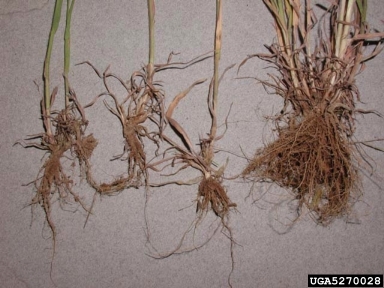Reproductive Strategies
Germination
Cheatgrass is an
annual, cool season grass which is known to be discreet because of
its small size (Speziale et al. 2013). For a more in depth
description, check out the interactions
page. It is an annual grass whose effects on the
environment can be clearly viewed from year to year because of its
dominant characteristics. The grass germinates in autumn, grows slowly, and by the end
of December is generally two to four centimeters tall. During
winter, the seedlings enter a semi-dormant state in order to survive.
 By spring time,
Cheatgrass resumes its lifecycle growing to
heights of around fifty to sixty centimeters. Cheatgrass is a
flowering plant which does so in the summer ( Zouhar 2003). Bromus
tectorum demonstrates a germination pattern that is indicative of
wintertime annuals (Bykova and Sage 2012) . During dispersion, the seeds are dormant, to
some degree. These seeds will start to grow when the conditions are right. If the
conditions are not favorable, the seed will become dormant again
until spring (Forbis 2010). The seeds of Bromus tectorum
have the potential to remain viable for up to five years (USDA 2005;
CalIPC 2014). This
means that even older seeds can grow after a period of time has passed.
By spring time,
Cheatgrass resumes its lifecycle growing to
heights of around fifty to sixty centimeters. Cheatgrass is a
flowering plant which does so in the summer ( Zouhar 2003). Bromus
tectorum demonstrates a germination pattern that is indicative of
wintertime annuals (Bykova and Sage 2012) . During dispersion, the seeds are dormant, to
some degree. These seeds will start to grow when the conditions are right. If the
conditions are not favorable, the seed will become dormant again
until spring (Forbis 2010). The seeds of Bromus tectorum
have the potential to remain viable for up to five years (USDA 2005;
CalIPC 2014). This
means that even older seeds can grow after a period of time has passed.
Seed Production and Dispersal
Bromus tectorum
reproduces by seed only (Forbis 2010). The species is mostly
autogamous which means it reproduces through self- fertilization or
pollination. These autogamous organisms for the most part go through
cleistogamy. Cleistogamy is defined as the process of a flowering
plant self- fertilizing without the flower opening (Zouhar 2003). In
other words, the fertilization happens internally. Even though
Cheatgrass is primarily a self-fertilizing organism, it also can
take part in cross fertilization. The type of breeding system is
environment dependent, allowing Bromus tectorum to adapt to the
surroundings. (Zouhar 2003) The seeds of the plant are typically
dispersed by the wind, but this is not always the case. The seed
coat of cheatgrass plants are covered in bristle like structures.
This allows for the seed coat to attach to the feathers or fur of
animals maximizing dispersal of the seeds. Also, it has the capacity
to produce up to three hundred seeds per plant (CalIPC 2014). Having a large seedbank is a reproductive
strategy that helps maintain population size. The seed are very
durable and can withstand high soil temperatures. Because of this,
along with Bromus tectorum’s ability to remain
dormant for long periods of time, it is believed that there are
twice as many seeds available as there are growing as established
plants. (CalIPC 2014) Even in drought conditions,
Bromus
tectorum can produce enough seeds to at least propagate itself for
the next growing season. Once the seeds have b een spread through
wind or animals, shoot growth can occur. The young plant extents
from its shoot apical meristem and the organs of a plant begin to
form (roots, stem, and leaves). This typically happens in early
spring and continues until most of the natural resources are
exploited from the area. (CalIPC 2014)
een spread through
wind or animals, shoot growth can occur. The young plant extents
from its shoot apical meristem and the organs of a plant begin to
form (roots, stem, and leaves). This typically happens in early
spring and continues until most of the natural resources are
exploited from the area. (CalIPC 2014)
Influence of Roots
Cheatgrass is a dominant and effective invasive species because the grass uses more water than the other plants early in the growing season. This allows for Bromus tectorum to have greater root and shoot growth rate because it initiates growth at lower temperatures in comparison to other species. (Parkinson et al. 2013) Cheatgrass produces roots around twenty centimeters long and then propels lateral roots out far distances within the soil. These lateral roots are how the plant is able to thrive so well. (CalIPC 2014) Cheatgrass also becomes denser in areas from year to year. An area of ten plants per meter squared can increase to around ten thousand plans per meter squared within three years. (Parkinson et al. 2013) This act limits the establishment of other species in the environment. For more information about the root system in Cheatgrass, take a look at the adaptation page.